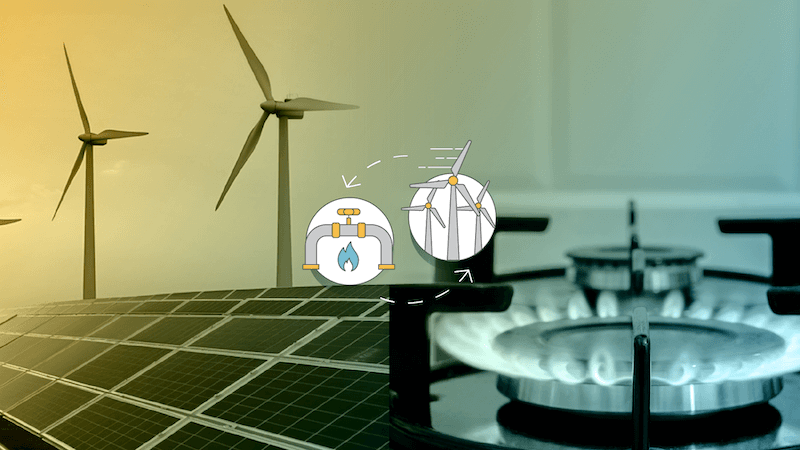Is Natural Gas Renewable?
The debate over whether natural gas is a renewable resource is pivotal in today’s energy and environmental landscape. Renewable energy, typically sourced from rapidly replenishing natural elements like sun, wind, and water, stands in contrast to fossil fuels, which include coal, oil, and conventional natural gas. These fossil fuels, formed over millions of years, are finite and linked to environmental issues like greenhouse gas emissions.
Natural gas, mainly methane, traditionally falls into the nonrenewable category due to its fossil origins and extraction methods like drilling and fracking. However, emerging technologies in biogas and renewable natural gas (RNG) challenge this notion. RNG, derived from decomposing organic waste in landfills and other sources, renews faster and potentially reduces environmental impacts.
Understanding whether natural gas can be considered renewable is more than an academic query. It has profound implications for energy policies, environmental sustainability, and the global shift towards cleaner energy sources.
Understanding Natural Gas
Natural gas, primarily composed of methane (CH4), is a key energy source globally. Methane, the simplest hydrocarbon, is efficient in energy production but also a potent greenhouse gas when released unburned. Natural gas is extracted mainly through drilling and hydraulic fracturing (fracking). Drilling taps into underground reserves, while fracking fractures rock formations with high-pressure fluids to release gas.
Though cleaner burning than coal or oil, natural gas extraction and usage pose environmental challenges. Fracking, in particular, raises concerns about groundwater contamination and seismic disturbances. Additionally, methane leakage during extraction and transportation significantly contributes to greenhouse gas emissions, a critical factor in global warming.
Understanding the chemical nature and extraction impacts of natural gas is essential in assessing its role in climate change, sustainable energy, and environmental stewardship.
Natural Gas and the Environment
While natural gas is the cleanest burning fossil fuel, its environmental impact, particularly in terms of greenhouse gas emissions, is significant. It releases less carbon dioxide (CO2) than coal or oil when burned, but the methane emissions from its extraction and distribution are a major environmental concern. Methane, far more potent than CO2 in terms of heat-trapping, significantly contributes to global warming.
Compared to renewable sources of energy like solar or wind power, natural gas production has a higher environmental footprint due to these emissions. Renewables typically have minimal or no direct greenhouse emissions, highlighting their superiority in environmental sustainability.
Regarding air quality, natural gas produces fewer particulates and air pollutants like sulfur dioxide and nitrogen oxides than other fossil fuels. However, its environmental benefit is undermined if methane leaks are not effectively controlled. Therefore, while offering some advantages over traditional fossil fuels, natural gas’s role in a sustainable future depends heavily on reducing its methane emissions and enhancing production efficiency.
Renewable Natural Gas (RNG)
Renewable natural gas (RNG), or biomethane, is a sustainable alternative to traditional natural gas, derived from organic waste sources such as landfills, agricultural waste, and wastewater treatment plants. This process captures methane produced from the decomposition of organic matter, usually through anaerobic digestion, and purifies it into RNG.
The environmental benefits of RNG are significant. By harnessing methane emissions from waste, RNG reduces the overall impact of this potent greenhouse gas. Unlike fossil fuel-based natural gas, RNG’s production and use can be carbon-neutral, as the CO2 released upon burning was recently captured from the atmosphere by the organic material from which RNG is produced.
This closed carbon cycle positions RNG closer to renewable energy sources in terms of sustainability and environmental impact. RNG not only offers a way to repurpose waste but also provides a cleaner, more sustainable energy option, underscoring its potential in a transition to cleaner energy systems.
RNG in Energy Production
Renewable natural gas (RNG) is gaining traction in the energy sector due to its versatility and environmental benefits. In power plants, RNG is a direct substitute for conventional natural gas, enabling a cleaner electricity generation process. This use significantly reduces the carbon footprint of power generation, as RNG captures methane emissions and displaces fossil fuel consumption.
In the transportation sector, RNG is utilized as a cleaner fuel alternative, replacing diesel and gasoline in vehicles. This switch results in lower emissions of harmful pollutants and greenhouse gases. Furthermore, RNG’s compatibility with existing gas pipelines allows it to be easily distributed for various uses, from heating to industrial processes.
RNG’s adaptability in power generation, transportation, and pipeline distribution highlights its role as a sustainable and clean energy source, fitting seamlessly into existing energy infrastructures and contributing to reduced environmental impacts.
Technological and Environmental Challenges
While renewable natural gas (RNG) presents a promising sustainable energy solution, its production and implementation face several technological and environmental challenges.
Technological challenges in RNG production:
- Feedstock availability. The production of RNG is contingent on the availability of organic waste materials. Securing a consistent and sufficient supply of these feedstocks, especially in regions with less agricultural or landfill waste, can be challenging.
- Gas purification. RNG production involves purifying biogas to remove impurities and increase methane concentration. This purification process is complex and requires advanced technology to ensure that the RNG meets quality standards for use in existing natural gas infrastructure.
Environmental concerns:
- Lifecycle methane emissions. Despite RNG’s potential to reduce greenhouse gas emissions, there are concerns about methane leakage during the production and distribution process. Effective capture and management of methane are critical to maximizing RNG’s environmental benefits.
- Resource utilization. The production of RNG requires resources, including land for waste storage and energy for processing. The environmental impact of these resource demands must be considered in evaluating RNG’s overall sustainability.
Technological advancements:
Recent technological developments are addressing these challenges. Innovations in feedstock processing techniques are expanding the range of usable organic materials, and advancements in gas purification technologies are improving efficiency and reducing the costs of RNG production. Additionally, improved methods for methane capture and leak detection are enhancing the environmental performance of RNG.
Despite these challenges, ongoing technological progress and increasing recognition of RNG’s benefits are driving its growth as a key component in the transition to cleaner energy systems.
Global and Regional Perspectives
The adoption and integration of renewable natural gas (RNG) vary significantly across the globe, with distinct regional approaches shaping its development and utilization. Examining the policies of California in the United States offers a window into how different regions are embracing RNG.
California‘s approach:
California, known for its progressive environmental policies, has been a frontrunner in advocating for RNG. The state has implemented incentives and regulations that promote the production and use of RNG, particularly in transportation. California’s Low Carbon Fuel Standard (LCFS) encourages the use of lower-carbon transportation fuels, including RNG, and provides credits that can be traded to offset the cost of RNG production and infrastructure development. This policy has significantly boosted RNG usage in the state, setting a benchmark for others to follow.
Global adoption rates and energy impacts:
Globally, the adoption of RNG varies widely. European countries, particularly those in Scandinavia, have made notable advances in integrating RNG into their energy mix. In contrast, adoption rates in developing countries are generally lower due to technological and infrastructural limitations. The impact of RNG on global energy needs is gradually increasing, but it is still a small fraction compared to traditional energy sources and other renewables like wind and solar.
Contrast with wind and solar energy:
RNG offers different advantages and challenges compared to wind and solar energy. While wind and solar power are dependent on geographical and weather conditions, RNG can be produced consistently from organic waste sources. However, RNG production is more complex and resource-intensive, and the technology for its extraction and purification is still evolving. In contrast, wind and solar technologies are more mature and have seen significant cost reductions.
The role of RNG in meeting global and regional energy needs is growing but remains influenced by local policies, resource availability, and technological advancements. Its development complements other renewable energy sources, contributing to a more diverse and sustainable energy landscape.
Evaluating the Renewable Potential of Natural Gas in a Sustainable Future
As we navigate the complexities of building a sustainable future, the role of natural gas, particularly in its renewable form (RNG), stands as a significant piece of the puzzle. RNG’s potential to transform organic waste into energy, reduce greenhouse gas emissions, and utilize existing gas infrastructures positions it as a noteworthy player in the renewable energy sector. This transformation of natural gas from a traditional fossil fuel (a nonrenewable energy source) to a renewable resource exemplifies the innovative approaches necessary in our global energy transition.
However, realizing the full potential of RNG requires a delicate balance between meeting our energy needs, ensuring sustainability, and achieving climate goals. This balance calls for continuous research to overcome technological and economic barriers and for robust policy support to foster the development and integration of RNG into our energy systems.
The journey towards a sustainable energy future is multifaceted and requires concerted efforts from various sectors. It’s vital that we continue to explore and support renewable energy options like RNG that can contribute to a diversified and environmentally responsible energy mix.
To further explore your energy options and contribute to a sustainable future, consider enrolling with Payless Power, where you can find innovative solutions that align with your energy needs and environmental goals.
What our customers are saying
See why our power customers say we're the best electricity provider in Texas!
I was worried about getting electricity for my home through a prepaid company. I was calling around to see different rates then going through all the hassle of credit checks while dropping points each…
I have been with this company for several years and have been very happy since. Even when I moved, they made my usually stressful situation very easy and carefree. I recommend them to everyone that I…
I have enjoyed the service for 2 years now. In the beginning this service was planned to be temporary but with the service being so effective for me i decided to keep it for the long haul. I’m a happy customer.









